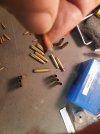Dissimilar metal corrosion is real. I would suggest why some people experiences it and some don't has to do primarily with the manufacturing process. Different vendors use different formulas for their brass. Bullet vendors vary the formula for the copper alloy to get the hardness and expansion they want. There are acceptable manufacturing tolerances from lot to lot. Given all these variables is why we see corrosion more prevalent with certain combinations of brass and bullets. After a round has been fired, there is a small change to the chemical composition of the brass in a very thin layer, especially around the neck due to heat, pressure and chemicals in the powder. This change is more prevalent in with certain powders since their chemical composition is slightly different.
The best way I have found to minimize this type of corrosion is to use a fine graphite power or some of the newer liquid formulas to coat the neck before bullet insertion. Lee Precision has a good product that can be used wet or dry.
Lastly, a best practice which someone mentioned previously, is to seat the bullet long before storage and then seat to their final COAL or base to ogive reading a day or so before a hunting trip.

